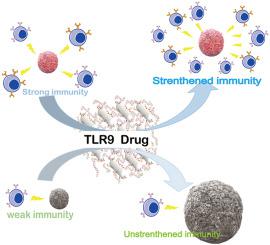Biomaterials ( IF 12.8 ) Pub Date : 2020-09-11 , DOI: 10.1016/j.biomaterials.2020.120379 Qun Xu 1 , Chengli Dai 1 , Jun Kong 1 , Hekai Chen 1 , Jie Feng 1 , Ying Zhang 1 , Hang Yin 1

|
TLR9 targeting has been a dynamic research field with promising potential in tumor immunotherapy. However, why most patients do not respond to TLR9 agonists remains unknown. In our attempt to resolve this issue, we observed that anti-tumor response to our TLR9-targeting cancer nanomedicines varied according to the initial immune profile of the animals. Speculating that immune profiling before treatment, including the measurement of IFN-α, IL-12, IL-6, TNF, tumor-infiltrating lymphocytes and spleen-residing lymphocytes, could be used to predictively distinguish responders from non-responders, we performed experiments in two different tumor models 4T1-BALB/c and B16–C57BL/6, to validate the hypothesis. Results confirmed that antitumor efficacy with respect to tumor growth, immune cell infiltration, and cytokines release, correlated with the different condition of individuals, as well as the categorization of the animals. This work suggests that immune profiling before treatment might be able to predict the antitumor efficacy of TLR9 agonists in vivo.
中文翻译:

治疗前的免疫分析可预测TLR9诱导的抗肿瘤功效。
TLR9靶向已成为一个动态的研究领域,在肿瘤免疫治疗中具有广阔的前景。但是,为什么大多数患者对TLR9激动剂不产生反应仍然未知。在我们解决这个问题的尝试中,我们观察到针对TLR9靶向癌症纳米药物的抗肿瘤反应根据动物的初始免疫特征而有所不同。推测治疗前的免疫分析,包括对IFN-α,IL-12,IL-6,TNF,肿瘤浸润淋巴细胞和脾脏淋巴细胞的测量,可用于预测性区分反应者和非反应者,我们进行了实验在两个不同的肿瘤模型4T1-BALB / c和B16–C57BL / 6中,以验证该假设。结果证实,针对肿瘤生长,免疫细胞浸润和细胞因子释放的抗肿瘤功效,与个体的不同状况以及动物的分类有关。这项工作表明治疗前的免疫分析可能能够预测TLR9激动剂的抗肿瘤功效体内。











































 京公网安备 11010802027423号
京公网安备 11010802027423号